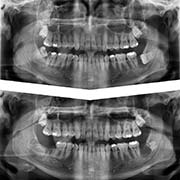What It Solves
A surgical extraction is a more complex procedure. It is used if a tooth may have broken off at the gum line or has not come into the mouth yet. Wisdom teeth, also called third molars, are often extracted either before or after they come in. They commonly come in during the late teens or early 20's. They need to be removed if they are decayed, cause pain or have a cyst or infection. These teeth often get stuck in the jaw (impacted) and do not come in. This can irritate the gum, causing pain and swelling. In this case, the tooth must be removed. If you need all four wisdom teeth removed, they are usually taken out at the same time.
How Is It Done
In the preoperative assessment period, the tooth to be extracted is carefully examined by the oral surgeon. Along with the tooth to be removed, oral surgeon will also assess the condition of adjacent teeth. X-ray of the tooth to be removed is taken. Periapical x-rays provide the most accurate and detailed information concerning the tooth, its roots and the surrounding tissue. Panoramic radiographs are used frequently, but their greatest usefulness is for impacted teeth as opposed to erupted teeth. X-rays tell about the relationship of the tooth to the associated vital structures, configuration of roots of tooth to be removed and condition of surrounding bone.
To numb the tooth extraction area, dental surgeon will give some shots of local anesthesia to the patient. To provide adequate visualization and access to the tooth, soft tissue and or bone is reflected. Tooth is luxated with elevators and tooth is removed. After tooth extraction, the ends of the flap are approximated with sutures or stitches.

